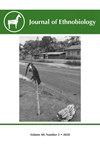Strengthening Relationships to Traditional Foodways: Adapting Food Practices Through Camas Cultivation Experiments on the Fort Hall Indian Reservation
IF 1.3
3区 社会学
Q1 ANTHROPOLOGY
引用次数: 0
Abstract
Contemporary efforts to strengthen Indigenous food sovereignty can take many forms, some of which may depart from traditional food gathering practices. Common camas (Camassia quamash) is a wild-gathered geophyte that served as a staple food for Indigenous Peoples prior to colonialism. Because the abundance of camas has declined and gathering areas are difficult to access, this project sought to increase Shoshone-Bannock Tribal citizen access to camas by experimenting with ways to grow camas locally. We also held events that provided an opportunity for Tribal citizens to interact with camas. Strengthening relationships with camas in these ways not only can enhance the health of Indigenous communities because of camas’ nutritional value, but also because renewing practices and values associated with camas brings Indigenous Peoples together to redefine and assert their nationhood. Our team of authors includes Tribal- and university-affiliated professionals and students who worked collaboratively to develop this project. We evaluated how different growing conditions and seed sources influence camas cultivation. We found that soil type, stratification setting, and seed source significantly affected seed percent germination. While cold-moist stratifying seeds in a controlled setting in potting soil generally led to the highest percent germination, soil type interacted with seed source, suggesting some degree of local adaptation across gathering areas. Transplanted bulbs had high survival rates, suggesting both seeds and bulbs as viable options to increase local access to camas. This project contributes to our understanding of camas ecology while also demonstrating one approach to help strengthen traditional foodways through Tribal-university partnerships.加强与传统食物方式的关系:在霍尔堡印第安保留地通过Camas栽培试验调整食物实践
当代加强土著粮食主权的努力可以采取多种形式,其中一些可能偏离传统的粮食采集做法。Common camas(Camassia quamash)是一种野生的水生植物,在殖民主义之前曾是土著人民的主食。由于卡马的数量已经减少,聚集区很难进入,该项目试图通过试验在当地种植卡马的方法来增加肖松尼-班诺克部落公民进入卡马的机会。我们还举办了一些活动,为部落公民提供了与卡马斯互动的机会。以这些方式加强与卡马斯的关系不仅可以提高土著社区的健康,因为卡马斯的营养价值,而且因为更新与卡马斯相关的做法和价值观将土著人民团结在一起,重新定义和维护他们的国家地位。我们的作者团队包括部落和大学附属的专业人员以及合作开发该项目的学生。我们评估了不同的生长条件和种子来源对卡马斯栽培的影响。我们发现土壤类型、分层环境和种子来源对种子发芽率有显著影响。虽然在盆栽土壤中的受控环境中对冷湿分层种子的发芽率通常最高,但土壤类型与种子来源相互作用,表明整个采集区存在一定程度的局部适应。移植球茎的存活率很高,这表明种子和球茎都是增加当地获得卡马斯的可行选择。该项目有助于我们了解卡马斯生态,同时也展示了一种通过部落大学合作伙伴关系来帮助加强传统饮食方式的方法。
本文章由计算机程序翻译,如有差异,请以英文原文为准。
求助全文
约1分钟内获得全文
求助全文
来源期刊

Journal of Ethnobiology
Social Sciences-Anthropology
CiteScore
4.80
自引率
3.40%
发文量
21
审稿时长
>12 weeks
期刊介绍:
JoE’s readership is as wide and diverse as ethnobiology itself, with readers spanning from both the natural and social sciences. Not surprisingly, a glance at the papers published in the Journal reveals the depth and breadth of topics, extending from studies in archaeology and the origins of agriculture, to folk classification systems, to food composition, plants, birds, mammals, fungi and everything in between.
Research areas published in JoE include but are not limited to neo- and paleo-ethnobiology, zooarchaeology, ethnobotany, ethnozoology, ethnopharmacology, ethnoecology, linguistic ethnobiology, human paleoecology, and many other related fields of study within anthropology and biology, such as taxonomy, conservation biology, ethnography, political ecology, and cognitive and cultural anthropology.
JoE does not limit itself to a single perspective, approach or discipline, but seeks to represent the full spectrum and wide diversity of the field of ethnobiology, including cognitive, symbolic, linguistic, ecological, and economic aspects of human interactions with our living world. Articles that significantly advance ethnobiological theory and/or methodology are particularly welcome, as well as studies bridging across disciplines and knowledge systems. JoE does not publish uncontextualized data such as species lists; appropriate submissions must elaborate on the ethnobiological context of findings.
 求助内容:
求助内容: 应助结果提醒方式:
应助结果提醒方式:


